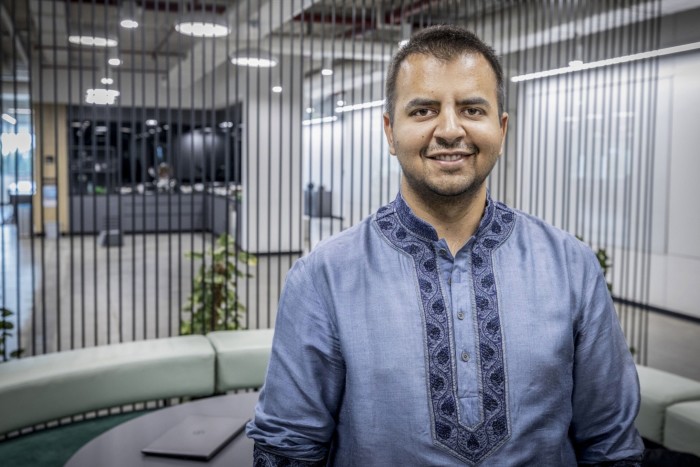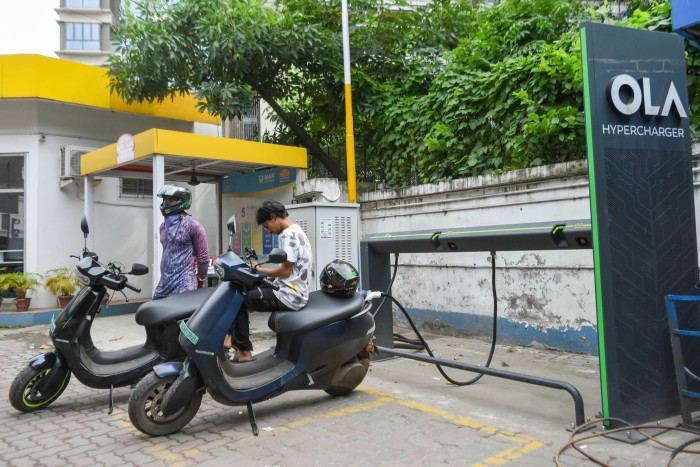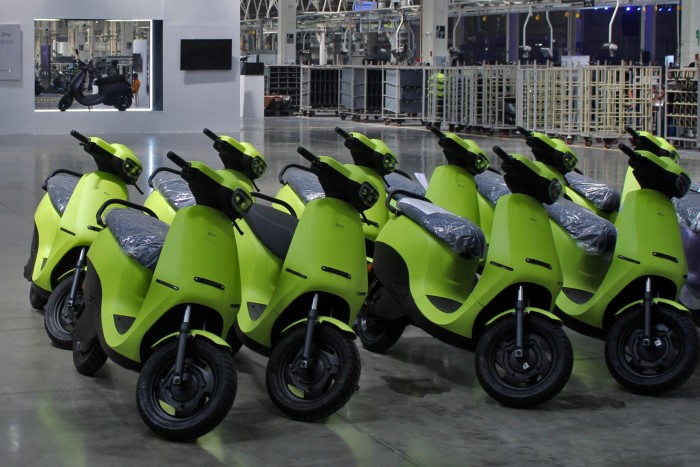Bhavish Aggarwal sees a public listing of his electric scooter business early this year as reflecting the significant contribution his colourful bikes have been making to India’s nascent EV market.
“Some companies need to be in the public domain given the scale of impact they have on society,” he said in a Financial Times interview ahead of an initial public offering by Ola Electric that is expected to be among the largest Indian IPOs of the past two years.
However, the hard-charging mobility entrepreneur is facing the challenges of tepid market interest in start-ups, high staff turnover, increased competition from established manufacturers, and a loss of government subsidies that is expected to make electric scooters less attractive to consumers.
Aggarwal co-founded the ride-hailing app Ola Cabs over a decade ago, before adding to his mobility empire by creating Ola Electric, and most recently expanding into artificial intelligence with start-up Krutrim. The scooter business said in December it would seek to raise Rs55bn ($661mn) in the IPO, with proceeds being used to build a battery factory in India, fund research and development, and pay off debts at the lossmaking start-up.
As India’s first listed electric vehicle company, Ola Electric would give investors an initial opportunity to bet on the country’s EV adoption, which is so far concentrated in two-wheelers in one of the world’s largest markets for vehicles. However, enthusiasm for richly valued newcomers has waned since the heady days of 2021. Then, internet companies including fintech, delivery and ecommerce services were all the rage, enjoying record listing sizes, only for their shares to sink soon after over concerns about profitability.

Aggarwal, who owns 37 per cent of Ola Electric, told the FT that the six-year-old EV company did not need more private capital following a Rs3.2bn funding round last year led by the Singapore government-owned investment fund Temasek, which valued the company at $5.4bn. Backers, who also include Japan’s SoftBank and US private equity firm Tiger Global, will offload part of their stakes in the sale. SoftBank’s Vision Fund is currently the biggest outside shareholder, with a 22 per cent stake.
The listing of Ola comes two years after it delivered its first scooter and Aggarwal attempted to float his ride-hailing service Ola Cabs, before he had to retreat in tough market conditions.
While Ola Cabs has been locked in a fierce battle with American rival Uber, Aggarwal said he was “very happy” with the business. He says it is profitable, although Ola Cabs said in 2018 it was facilitating a billion rides per year and now cites a more modest 550mn annual rides.
At Ola Electric, losses before tax widened to Rs14.7bn for the financial year ending in March 2023 from Rs7.8bn the previous year, as it established a giant scooter factory in the southern state of Tamil Nadu and began its development of battery cell production. However, total revenue for the 2023 financial year was Rs27.8bn, around six times higher than the Rs4.6bn the previous year.
Although New Delhi has backed the electrification of India’s two-wheelers with generous subsidies in recent years, they still only make up 5 per cent of the overall scooter market, according to HSBC analysts. And as government support programmes wind down, the challenge is keeping prices competitive. HSBC estimates that the cost of manufacturing e-scooters is still up to three times higher than a fuel-burning equivalent, while the retail price of an Ola two-wheeler is about Rs120,000 ($1,500) compared to the popular non-electric Honda Activa scooter at about Rs76,000.

While Ola Electric dominates the small but growing market in electric scooters with about a third of sales, it is now facing competition from the likes of Honda and established Indian automakers such as Hero and Bajaj looking to make their own EV scooters.
Auto analyst Basudeb Banerjee at ICICI Securities said Ola Electric’s market share is likely to shrink but “for Ola to operate at about 20, 25 per cent sustainable market share in e-scooters is definitely doable”.
Two-wheeler sales have surged since 2021, when monthly sales in the e-scooter market were less than 20,000 in India, to a high of more than 100,000 last May. But as the government’s subsidy programme has been wound down, sales have fallen. In December, fewer than 80,000 e-scooters were sold.
Ola Electric also aims to produce electric cars and has been designing batteries that it hopes to put into commercial production this year, after missing Aggarwal’s previous 2023 deadline.
Although it has achieved sales of more than 250,000 scooters a year, taking the product to market has been challenging. Selling to consumers online, Ola Electric has suffered customer complaints about delayed deliveries and problems with its aftersales service. It had to offer to replace the front fork on the S1 and S1 Pro, its first models to be sold, after what it said were “unfounded” safety concerns.
Aggarwal said the mass part replacement “was not technically a recall”, rather it “was a voluntary thing . . . Just because we did it proactively, doesn’t make it a widespread issue”.
It also had to refund thousands of customers after being accused of “mispricing” scooters. It had sold the scooter’s charger separately in order to keep the price down in line with the subsidy scheme.
Aggarwal said the company “had planned for reducing our cost structure with the objective of keeping our gross margins healthy as subsidies taper off” and he acknowledged there had been aftersales issues.
“We have again been very open about the fact that our service network is lagging our sales,” he said, but “we are expanding our service network very fast”. He added that Ola Electric’s digital model meant complaints were often more visible than with traditional automakers, which tend to deal with issues offline at service centres.

EV batteries, including Ola’s, have been scrutinised after a series of vehicle blazes. India’s highways ministry fined Ola Electric Rs1.5mn in 2022 after one of its scooters caught fire, leading the road authorities to administer tests on its batteries that Ola argued were unfair.
Seen by his supporters as India’s answer to Elon Musk but by detractors as a boss who demands too much of his workers, Aggarwal has defended Ola Electric’s “intense” work culture.
“This is my purpose, this is my life,” he said. “I’m not here to win friends and be happy ever after. We obviously have to be respectful. And we’ve gotten here only because we’ve been good enough with our stakeholders, our suppliers, our people, our partners.”
He denied that staff churn was unusually high, and said the company attracted top talent. “People need to come in with fire in their belly,” he added, estimating the company’s working hours are probably 20-30 per cent higher than is normal in India. “We’ve made some hiring mistakes probably in the past, we’ve learned from them,” he said.
However, according to the IPO filings, Ola Electric had an employee attrition rate of 47 per cent in its last financial year. That is more than double India’s average rate of 21 per cent in 2022, according to a report by professional services firm Aon.
“The kind of aggressiveness, the kind of multitasking he does, some people like it, some people may not,” said ICICI Securities’ Banerjee, while pointing out that Aggarwal’s methods had achieved results.
“Making an empire of e-two wheelers of this scale in a few years’ timeframe, this is tangible,” he said.




